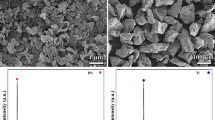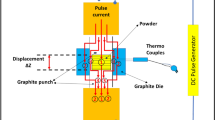Abstract
The manufacture of carbonated hydroxyapatite-based bioceramics with control of the composition and microstructure remains challenging and reveals our lack of knowledge regarding the thermal behavior of such materials, particularly at high temperatures under reactive atmospheres. This work lays a foundation for addressing this issue by investigating the solid–gas exchange reactions occurring between oxy-hydroxyapatites (OxHA) and a CO2-rich atmosphere during thermal treatment. Accordingly, OxHA reference powders with different oxygen contents (0 ≤ x ≤ 0.79) were produced, extensively characterized and heat-treated under a CO2-rich atmosphere at 950 °C for 5 h. The results of physicochemical, thermal and microstructural analyses showed that the A-site composition of OxHA controls the exchange reactions: a high initial OH content induced concomitant A-site dehydration and carbonation; conversely, a high OH vacancy content induced A-site hydration as a first step. Furthermore, the specific surface area significantly influenced the solid–gas exchange reactions by controlling their kinetic.








Similar content being viewed by others
References
Campana V, Milano G, Pagano E, Barba M, Cicione C, Salonna G, et al. Bone substitutes in orthopaedic surgery: from basic science to clinical practice. J Mater Sci-Mater M. 2014;25(10):2445–61. https://doi.org/10.1007/s10856-014-5240-2.
Marchat D, Champion E. Chapter 8: ceramic devices for bone replacement: mechanical and clinical issues. In: Palmero P, Barra ED, Cambier F, editors. Advances in ceramic biomaterials medical and commercial requirements. Woodhead publishing, Elsevier; 2017. p. 279–311. https://doi.org/10.1016/B978-0-08-100881-2.00008-7.
Porter A, Patel N, Brooks R, Best S, Rushton N, Bonfield W. Effect of carbonate substitution on the ultrastructural characteristics of hydroxyapatite implants. J Mater Sci Mater Med. 2005;16(10):899–907. https://doi.org/10.1007/s10856-005-4424-1.
Spence G, Patel N, Brooks R, Bonfield W, Rushton N. Osteoclastogenesis on hydroxyapatite ceramics: the effect of carbonate substitution. J Biomed Mater Res A. 2010;92(4):1292–300. https://doi.org/10.1002/jbm.a.32373.
Barralet J, Akao M, Aoki H, Aoki H. Dissolution of dense carbonate apatite subcutaneously implanted in Wistar rats. J Biomed Mater Res. 2000;49(2):176–82. https://doi.org/10.1002/(sici)1097-4636(200002)49:2%3C176::aid-jbm4%3E3.0.co;2-8.
Detsch R, Mayr H, Ziegler G. Formation of osteoclast-like cells on HA and TCP ceramics. Acta Biomater. 2008;4(1):139–48. https://doi.org/10.1016/j.actbio.2007.03.014.
Calori GM, Mazza E, Colombo M, Ripamonti C. The use of bone-graft substitutes in large bone defects: Any specific needs? Injury. 2011;42:S56–63. https://doi.org/10.1016/j.injury.2011.06.011.
Collins KL, Gates EM, Gilchrist CL, Hoffman BD. Chapter 1: bio-instructive cues in scaffolds for musculoskeletal tissue engineering and regenerative medicine. In: Brown JL, Kumbar SG, Banik BL, editors. Bio-instructive scaffolds for musculoskeletal tissue engineering and regenerative medicine. Academic Press; 2017. p. 3–35. https://doi.org/10.1016/B978-0-12-803394-4.00001-X.
Rey C, Combes C, Drouet C, Glimcher MJ. Bone mineral: update on chemical composition and structure. Osteoporosis Int. 2009;20(6):1013–21. https://doi.org/10.1007/s00198-009-0860-y.
Cazalbou S, Combes C, Eichert D, Rey C. Adaptative physico-chemistry of bio-related calcium phosphates. J Mater Chem. 2004;14(14):2148–53. https://doi.org/10.1039/B401318B.
Melville AJ, Harrison J, Gross KA, Forsythe JS, Trounson AO, Mollard R. Mouse embryonic stem cell colonisation of carbonated apatite surfaces. Biomaterials. 2006;27(4):615–22. https://doi.org/10.1016/j.biomaterials.2005.06.028.
Habraken W, Habibovic P, Epple M, Bohner M. Calcium phosphates in biomedical applications: Materials for the future? Mater Today. 2016;19(2):69–87. https://doi.org/10.1016/j.mattod.2015.10.008.
Paré A, Charbonnier B, Tournier P, Vignes C, Veziers J, Lesoeur J, et al. Tailored three-dimensionally printed triply periodic calcium phosphate implants: a preclinical study for craniofacial bone repair. ACS Biomater Sci Eng. 2020;6(1):553–63. https://doi.org/10.1021/acsbiomaterials.9b01241.
Barrere F, van Blitterswijk CA, de Groot K. Bone regeneration: molecular and cellular interactions with calcium phosphate ceramics. Int J Nanomed. 2006;1(3):317–32.
Spence G, Phillips S, Campion C, Brooks R, Rushton N. Bone formation in a carbonate-substituted hydroxyapatite implant is inhibited by zoledronate: the importance of bioresorption to osteoconduction. J Bone Joint Surg Br. 2008;90(12):1635–40. https://doi.org/10.1302/0301-620X.90B12.20931.
Nelson DG. The influence of carbonate on the atomic structure and reactivity of hydroxyapatite. J Dent Res. 1981;60 Spec No C:1621–9. https://doi.org/10.1177/0022034581060003s1201.
Rupani A, Hidalgo-Bastida LA, Rutten F, Dent A, Turner I, Cartmell S. Osteoblast activity on carbonated hydroxyapatite. J Biomed Mater Res Part A. 2012;100A(4):1089–96. https://doi.org/10.1002/jbm.a.34037.
Pieters IY, Van den Vreken NM, Declercq HA, Cornelissen MJ, Verbeeck RM. Carbonated apatites obtained by the hydrolysis of monetite: influence of carbonate content on adhesion and proliferation of MC3T3-E1 osteoblastic cells. Acta Biomater. 2010;6(4):1561–8. https://doi.org/10.1016/j.actbio.2009.11.002.
Bonel G. Contribution à l’étude de la carbonatation des apatites. Ann Chim. 1972;7:65–88.
Fleet ME. Carbonated hydroxyapatite: materials, synthesis, and applications. 1st ed. Jenny Stanford Publishing; 2015.
Redey SA, Nardin M, Bernache-Assollant D, Rey C, Delannoy P, Sedel L, et al. Behavior of human osteoblastic cells on stoichiometric hydroxyapatite and type A carbonate apatite: role of surface energy. J Biomed Mater Res. 2000;50(3):353–64. https://doi.org/10.1002/(sici)1097-4636(20000605)50:3%3C353::aid-jbm9%3E3.0.co;2-c.
Li B, Liao X, Zheng L, He H, Wang H, Fan H, et al. Preparation and cellular response of porous A-type carbonated hydroxyapatite nanoceramics. Mater Sci Eng C. 2012;32(4):929–36. https://doi.org/10.1016/j.msec.2012.02.014.
Labarthe J-C, Bonnel G, Montel G. Sur la structure et les propriétés des apatites carbonatées de type B phospho-calcique. Ann Chim. 1973;8:289–301.
Douard N, Leclerc L, Sarry G, Bin V, Marchat D, Forest V, et al. Impact of the chemical composition of poly-substituted hydroxyapatite particles on the in vitro pro-inflammatory response of macrophages. Biomed Microdevices. 2016;18(2):9. https://doi.org/10.1007/s10544-016-0056-0.
Boyer A, Marchat D, Bernache-Assollant D. Synthesis and characterization of Cx-Siy-HA for bone tissue engineering application. Key Eng Mat. 2013;529–530:100–4. https://doi.org/10.4028/www.scientific.net/KEM.529-530.100.
Vignoles M, Bonel G, Holcomb DW, Young RA. Influence of preparation conditions on the composition of type-B carbonated hydroxyapatite and on the localization of carbonate ions. Calcified Tissue Inter. 1988;43(1):33–40. https://doi.org/10.1007/BF02555165.
Lafon JP, Champion E, Bernache-Assollant D, Gibert R, Danna AM. Thermal decomposition of carbonated calcium phosphate apatites. J Therm Anal Calorim. 2003;72(3):1127–34. https://doi.org/10.1023/A:1025036214044.
Lafon JP, Champion E, Bernache-Assollant D. Processing of AB-type carbonated hydroxyapatite Ca10-x(PO4)6–x(CO3)x(OH)2–x-2y(CO3)y ceramics with controlled composition. J Eur Ceram Soc. 2008;28(1):139–47. https://doi.org/10.1016/j.jeurceramsoc.2007.06.009.
Rustom LE, Boudou T, Lou S, Pignot-Paintrand I, Nemke BW, Lu Y, et al. Micropore-induced capillarity enhances bone distribution in vivo in biphasic calcium phosphate scaffolds. Acta Biomater. 2016;44:144–54. https://doi.org/10.1016/j.actbio.2016.08.025.
Davison NL, Luo X, Schoenmaker T, Everts V, Yuan H, Barrère-de Groot F, et al. Submicron-scale surface architecture of tricalcium phosphate directs osteogenesis in vitro and in vivo. Eur Cell Mater. 2014;27:281–97. https://doi.org/10.22203/ecm.v027a20.
Zhang J, Barbieri D, ten Hoopen H, de Bruijn JD, van Blitterswijk CA, Yuan H. Microporous calcium phosphate ceramics driving osteogenesis through surface architecture. J Biomed Mater Res A. 2015;103(3):1188–99. https://doi.org/10.1002/jbm.a.35272.
Bouet G, Marchat D, Cruel M, Malaval L, Vico L. In vitro three-dimensional bone tissue models: from cells to controlled and dynamic environment. Tissue Eng Part B Rev. 2015;21(1):133–56. https://doi.org/10.1089/ten.teb.2013.0682.
Murphy WL, McDevitt TC, Engler AJ. Materials as stem cell regulators. Nat Mater. 2014;13(6):547–57. https://doi.org/10.1038/nmat3937.
Davison NL, Su J, Yuan H, van den Beucken JJ, de Bruijn JD, Barrère-de GF. Influence of surface microstructure and chemistry on osteoinduction and osteoclastogenesis by biphasic calcium phosphate discs. Eur Cell Mater. 2015;29:314–29. https://doi.org/10.22203/ecm.v029a24.
Trombe JC, Montel G. Some features of the incorporation of oxygen in different oxidation states in the apatitic lattice—II On the synthesis and properties of calcium and strontium peroxiapatites. J Inorg Nucl Chem. 1978;40(1):23–6. https://doi.org/10.1016/0022-1902(78)80299-1.
Seuter AMJH. Existence region of calcium hydroxyapatite and the equilibrium with coexisting phases at elevated temperatures. In: Anderson JSRM, Stone FS, editors. Reactivity of solids. London: Chapman et Hall; 1972.
Raynaud S, Champion E, Bernache-Assollant D. Calcium phosphate apatites with variable Ca/P atomic ratio II. Calcination and sintering. Biomaterials. 2002;23(4):1073–80. https://doi.org/10.1016/S0142-9612(01)00219-8.
Zhou J, Zhang X, Chen J, Zeng S, De Groot K. High temperature characteristics of synthetic hydroxyapatite. J Mater Sci Mater Med. 1993;4(1):83–5. https://doi.org/10.1007/BF00122983.
Locardi B, Pazzaglia UE, Gabbi C, Profilo B. Thermal behaviour of hydroxyapatite intended for medical applications. Biomaterials. 1993;14(6):437–41. https://doi.org/10.1016/0142-9612(93)90146-s.
Van Landuyt P, Li F, Keustermans JP, Streydio JM, Delannay F, Munting E. The influence of high sintering temperatures on the mechanical properties of hydroxylapatite. J Mater Sci Mater Med. 1995;6(1):8–13. https://doi.org/10.1007/BF00121239.
Adolfsson E, Nygren M, Hermansson L. Decomposition mechanisms in aluminum oxide-apatite systems. J Am Ceram Soc. 1999;82(10):2909–12. https://doi.org/10.1111/j.1151-2916.1999.tb02176.x.
Riboud PV. Composition et stabilité des phases à structure d’apatite dans le système CaO-P2O5-oxyde de fer-H2O à haute température. Ann Chim. 1973;8:381–90.
Alberius-Henning P, Adolfsson E, Grins J, Fitch A. Triclinic oxy-hydroxyapatite. J Mater Sci. 2001;36(3):663–8. https://doi.org/10.1023/A:1004876622105.
Yoder CH, Pasteris JD, Worcester KN, Schermerhorn DV. Structural water in carbonated hydroxylapatite and fluorapatite: confirmation by solid state 2H NMR. Calcified Tissue Int. 2012;90(1):60–7. https://doi.org/10.1007/s00223-011-9542-9.
Wang T, Dorner-Reisel A, Müller E. Thermogravimetric and thermokinetic investigation of the dehydroxylation of a hydroxyapatite powder. J Eur Ceram Soc. 2004;24(4):693–8. https://doi.org/10.1016/S0955-2219(03)00248-6.
Rey C, Collins B, Goehl T, Dickson IR, Glimcher MJ. The carbonate environment in bone mineral: a resolution-enhanced Fourier Transform Infrared Spectroscopy study. Calcified Tissue Int. 1989;45(3):157–64. https://doi.org/10.1007/BF02556059.
Charbonnier B. Développement de procédés de mise en forme et de caractérisation pour l’élaboration de biocéramiques en apatites phosphocalcique carbonatées. Univ Lyon; 2016.
Liao CJ, Lin FH, Chen KS, Sun JS. Thermal decomposition and reconstitution of hydroxyapatite in air atmosphere. Biomaterials. 1999;20(19):1807–13. https://doi.org/10.1016/S0142-9612(99)00076-9.
Wilson EE, Awonusi A, Morris MD, Kohn DH, Tecklenburg MMJ, Beck LW. Three structural roles for water in bone observed by solid-state NMR. Biophys J. 2006;90(10):3722–31. https://doi.org/10.1529/biophysj.105.070243.
Pajchel L, Kolodziejski W. Solid-state MAS NMR, TEM, and TGA studies of structural hydroxyl groups and water in nanocrystalline apatites prepared by dry milling. J Nanopart Res. 2013;15(8):1868. https://doi.org/10.1007/s11051-013-1868-y.
Nowicki DA, Skakle JMS, Gibson IR. Faster synthesis of A-type carbonated hydroxyapatite powders prepared by high-temperature reaction. Adv Powder Technol. 2020;31(8):3318–27. https://doi.org/10.1016/j.apt.2020.06.022.
LeGeros RZ, Trautz OR, Klein E, LeGeros JP. Two types of carbonate substitution in the apatite structure. Cell Mol Life Sci. 1969;25(1):5–7. https://doi.org/10.1007/bf01903856.
Driessens FCM, Verbeeck RMH, Heijligers HJM. Some physical properties of Na- and CO3-containing apatites synthesized at high temperatures. Inorg Chim Acta. 1983;80:19–23. https://doi.org/10.1016/S0020-1693(00)91256-8.
Barralet JE, Fleming GJP, Campion C, Harris JJ, Wright AJ. Formation of translucent hydroxyapatite ceramics by sintering in carbon dioxide atmospheres. J Mater Sci. 2003;38(19):3979–93. https://doi.org/10.1023/A:1026258515285.
Jebri S, Khattech I, Jemal M. Standard enthalpy, entropy and Gibbs free energy of formation of «A» type carbonate phosphocalcium hydroxyapatites. J Chem Thermodyn. 2017. https://doi.org/10.1016/j.jct.2016.10.035.
Vieillard P, Tardy Y. Thermochemical Properties of Phosphates. In: Nriagu JO, Moore PB, editors. Phosphate minerals. Berlin: Springer; 1984. p. 171–98. https://doi.org/10.1007/978-3-642-61736-2_4.
Acknowledgements
We acknowledge Coralie Laurent from Mines Saint Etienne and Philipe Steyer and Annie Malchère from INSA Lyon for technical help.
Funding
This study was funded by the Auvergne-Rhone Alpes region (ARC2 program, PhD fellowship to SG).
Author information
Authors and Affiliations
Contributions
All authors contributed to the study conception and design. Material preparation, data collection and analysis were performed by SG, ND and DM. The first draft of the manuscript was written by SG and DM, and all authors commented on previous versions of the manuscript. All authors read and approved the final manuscript.
Corresponding author
Ethics declarations
Conflict of interest
The authors have no competing interests to declare that are relevant to the content of this article.
Additional information
Publisher's Note
Springer Nature remains neutral with regard to jurisdictional claims in published maps and institutional affiliations.
Rights and permissions
Springer Nature or its licensor holds exclusive rights to this article under a publishing agreement with the author(s) or other rightsholder(s); author self-archiving of the accepted manuscript version of this article is solely governed by the terms of such publishing agreement and applicable law.
About this article
Cite this article
Guillou, S., Douard, N., Tadier, S. et al. The key role of the A-site composition of oxy-hydroxyapatites in high-temperature solid–gas exchange reactions. J Therm Anal Calorim 147, 13135–13150 (2022). https://doi.org/10.1007/s10973-022-11512-3
Received:
Accepted:
Published:
Issue Date:
DOI: https://doi.org/10.1007/s10973-022-11512-3




